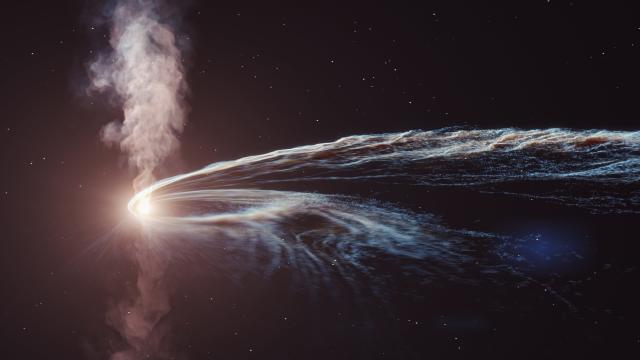In June 2021, a radio telescope in New Mexico picked up signs that a black hole had begun flinging material into space, the astrophysical equivalent of spitting up your food. But here’s the rub: It hadn’t eaten anything in years.
A team of astronomers observed the ejection event using six observatories: four across North America, South America, Africa and Australia, and two in space. The team linked the 2021 rejectamenta to a star consumed by the black hole three years ago. The team’s research is published this week in The Astrophysical Journal.
“This caught us completely by surprise — no one has ever seen anything like this before,” Yvette Cendes, a research associate at the Centre for Astrophysics | Harvard & Smithsonian and the study’s lead author, said in a centre release.
The radio-bright event is dubbed AT2018hyz. It is a tidal disruption event, which is when a star passing too near a black hole gets pulled apart, or spaghettified. The spaghettified star material then orbits the black hole in its accretion disk, rather than being sucked past the inescapable event horizon immediately. That material heats up, creating signals that astronomers can detect from Earth. Sometimes tidal disruption events are quick; other times, the stars are slowly torn apart as they orbit the black holes.
Black holes are messy eaters, so it’s not unusual for them to fling stellar material back into space. But three years is an uncommonly long time for a black hole to keep its lunch down. Normally, when a star is spaghettified by a black hole, the regurgitations are pretty immediate.
In this case, the black hole held the stellar material for years before spewing it out at half the speed of light — extraordinarily fast, as the outflow from most tidal disruption events travels at about 10% the speed of light. “It’s as if this black hole has started abruptly burping out a bunch of material from the star it ate years ago,” Cendes said.
The team believes that delayed outflows like that of AT2018hyz may be more common than previously believed. To figure that out, astronomers will need to look at the sites of more tidal disruption events that have already passed out of mind. It could be that these presumed-over events have yet more action in their futures.
More: A Star Fell Into a Black Hole, Revealing Its Super-Fast Spin
